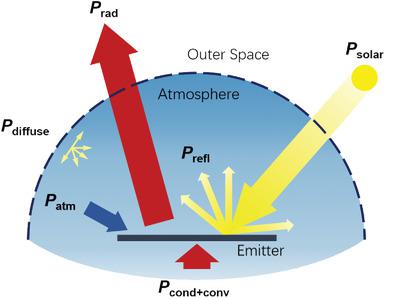当前位置:
X-MOL 学术
›
Adv. Mater. Technol.
›
论文详情
Our official English website, www.x-mol.net, welcomes your
feedback! (Note: you will need to create a separate account there.)
Fundamentals, Materials, and Applications for Daytime Radiative Cooling
Advanced Materials Technologies ( IF 6.4 ) Pub Date : 2020-02-24 , DOI: 10.1002/admt.201901007 Zizhong Li 1 , Qiyuan Chen 1 , Yan Song 1 , Bin Zhu 1 , Jia Zhu 1
Advanced Materials Technologies ( IF 6.4 ) Pub Date : 2020-02-24 , DOI: 10.1002/admt.201901007 Zizhong Li 1 , Qiyuan Chen 1 , Yan Song 1 , Bin Zhu 1 , Jia Zhu 1
Affiliation

|
Daytime radiative cooling is emerging as a passive and environmentally friendly cooling strategy, compared to traditional cooling methods that consume a vast amount of energy with a significant carbon footprint. To achieve the best cooling performance, materials tailored for daytime radiative cooling need to generate high emission in the atmospheric transmission window (8–13 µm) for radiating heat out directly to the universe and simultaneously reflect the entire solar radiation to minimize the thermal load. Recently, daytime subambient radiative cooling has been demonstrated through a range of novel material strategies. Herein, the fundamental principles for nighttime and daytime radiative cooling are summarized, and different designs of materials and structures suitable for substantial cooling performances are highlighted, together with various real‐world applications including building, water cooling, and clothing. Several possible pathways of daytime radiative cooling for further development are also outlined. It is anticipated that this review will provide an overall picture of recent progress and inspire more efforts into the fundamental understanding and practical applications of daytime radiative cooling.
中文翻译:

白天辐射冷却的基本原理,材料和应用
与传统的散热方法相比,白天的辐射散热正在成为一种被动的,对环境友好的散热策略,而传统的散热方法会消耗大量的能源并产生大量的碳足迹。为了获得最佳的冷却性能,为日间辐射冷却量身定制的材料需要在大气传输窗口(8–13 µm)中产生高发射量,以将热量直接辐射到宇宙并同时反射整个太阳辐射,以最大程度地降低热负荷。最近,通过一系列新颖的材料策略已经证明了白天的低温辐射冷却。本文总结了夜间和白天辐射冷却的基本原理,并着重介绍了适合实际冷却性能的材料和结构的不同设计,以及各种实际应用,包括建筑,水冷和服装。还概述了白天辐射冷却进一步发展的几种可能途径。预计这次审查将提供近期进展的总体情况,并激发人们对日间辐射冷却的基本理解和实际应用进行更多的努力。
更新日期:2020-02-24
中文翻译:

白天辐射冷却的基本原理,材料和应用
与传统的散热方法相比,白天的辐射散热正在成为一种被动的,对环境友好的散热策略,而传统的散热方法会消耗大量的能源并产生大量的碳足迹。为了获得最佳的冷却性能,为日间辐射冷却量身定制的材料需要在大气传输窗口(8–13 µm)中产生高发射量,以将热量直接辐射到宇宙并同时反射整个太阳辐射,以最大程度地降低热负荷。最近,通过一系列新颖的材料策略已经证明了白天的低温辐射冷却。本文总结了夜间和白天辐射冷却的基本原理,并着重介绍了适合实际冷却性能的材料和结构的不同设计,以及各种实际应用,包括建筑,水冷和服装。还概述了白天辐射冷却进一步发展的几种可能途径。预计这次审查将提供近期进展的总体情况,并激发人们对日间辐射冷却的基本理解和实际应用进行更多的努力。











































 京公网安备 11010802027423号
京公网安备 11010802027423号